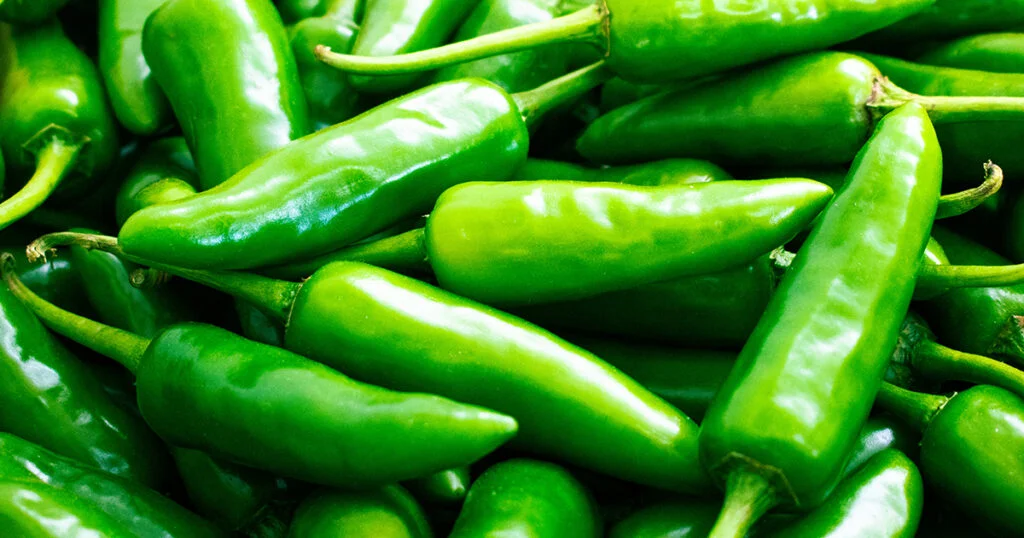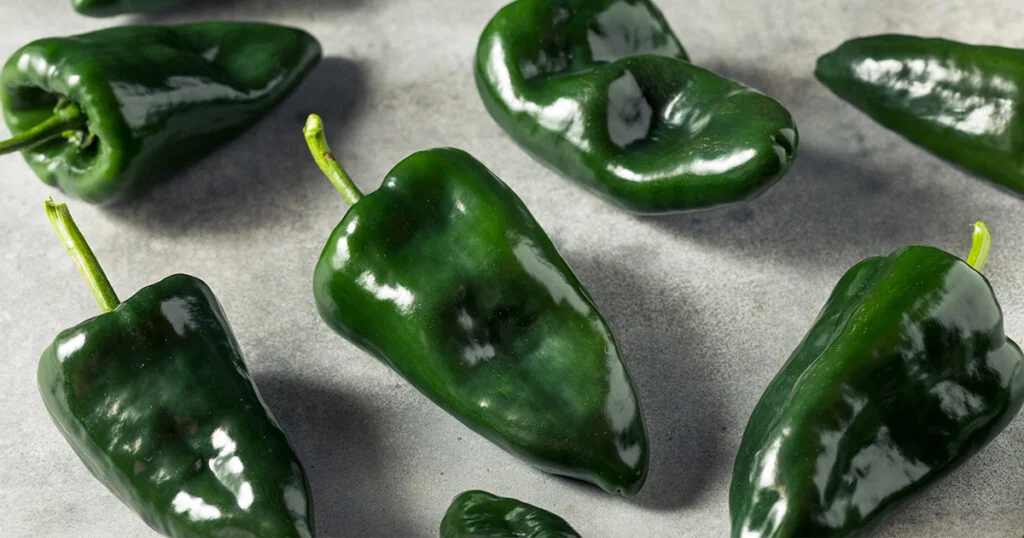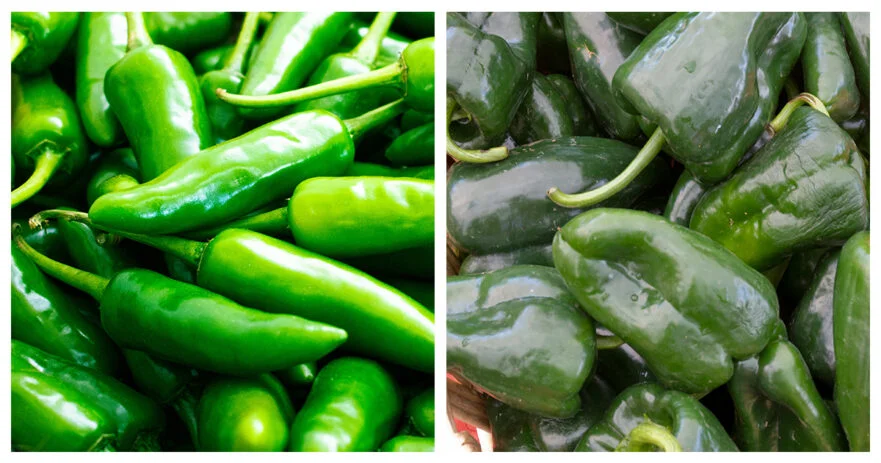Peppers, the world’s most famous spice carrier, have been seasoning our dishes and delighting our palates for centuries. While some make their presence known with ferocious zeal, others, such as the Anaheim and Poblano, serenade with a gentler touch. While both peppers are members of the same family, their flavor profiles and characteristics differ slightly, like nuances in stories from different cultures. As we delve deeper into the complexities of these two peppers in the sections ahead, you’ll be equipped with the knowledge to discern their distinct characteristics, ensuring you choose the best pepper for your culinary masterpiece.
| Anaheim pepper | Poblano pepper | |
| SHU | 500 - 2,500 | 1,000 - 1,500 |
| Median SHU | 1,500 | 1,250 |
| Flavor | Mild, sweet and fruity, tangy | Mild, rich and earthy flavor |
| Species | Capsicum annuum | Capsicum annuum |
| Origin | USA | Mexico |
| Uses | Grilled, stuffed, salsas | Stuffed, roasted, sauces |
Table of contents
What is Anaheim Pepper?

The Anaheim pepper, named after the Southern California city of Anaheim, has a sleek, elongated form that is usually green but can turn red as it ripens. While many people enjoy the whole pepper in various dishes, the Anaheim is also commonly dried, earning it the moniker “chile seco del norte.”
The Anaheim pepper has a mild kick in terms of heat, measuring between 500 and 2,500 on the Scoville scale. This milder heat makes it an excellent choice for those who prefer spicy but not overpowering dishes.
The Anaheim pepper’s subtle spiciness and slight sweetness have cemented its status in many culinary circles. Chefs and home cooks commonly use it in traditional Mexican dishes like chiles rellenos, and enchiladas. Its thick flesh lends itself well to stuffing, and its mild flavor complements but does not overpower other ingredients.
The Anaheim pepper’s versatility extends beyond traditional dishes to contemporary culinary creations. Its balanced heat profile enables it to serve as a bridge for those transitioning to spicier flavors. People frequently use this transitional quality when creating fusion cuisines, where the pepper adds a hint of heat without alienating those unfamiliar with spicy foods.
Furthermore, people love grilling the Anaheim pepper. Its tough skin chars beautifully, releasing a smoky aroma that complements its sweetness. When roasted, the skin easily peels away, revealing tender flesh with a deep, smoky flavor, making it an excellent addition to salads, salsas, and grilled dishes.
What is Poblano Pepper?

The poblano pepper, originating in Puebla, Mexico, is distinguished by its broader, somewhat heart-shaped appearance and deep green color. This color develops into a dark reddish-brown as it matures. When dried, this versatile pepper takes on a new name: “ancho chile.”
With a Scoville rating ranging from 1,000 to 1,500, the poblano provides a mild to medium level of heat and is also prized for its rich, earthy flavor, making it a favorite in many kitchens. This flavor profile shines brightest in mole sauces, where its depth blends harmoniously with ingredients like chocolate and spices, creating a unique tapestry of flavor that balances sweet, spicy, and savory notes.
Another of the poblano’s many strengths is its structural integrity. Its thick walls make it ideal for stuffing, with dishes like chiles en nogada highlighting its robustness and flavor. The pepper’s flesh remains intact during cooking, making it an ideal vessel for several fillings ranging from cheeses to meats.
Furthermore, the poblano’s adaptability is evident in its preparation; whether roasted to bring out smoky undertones, grilled, fried, or served raw in salads, the poblano is a testament to culinary versatility. Many fusion dishes have discovered that incorporating the poblano can infuse a dish with traditional Mexican essence while allowing for innovative flavor combinations.
What are the Similarities Between Anaheim and Poblano?
Anaheim and poblano peppers are deeply rooted in Mexico’s rich culinary traditions, serving as the foundation stones for many classic dishes. As their popularity grew, chefs from all over the world incorporated them into many cuisines, highlighting their adaptable flavors and versatility.
Their similarities in preparation and culinary application are obvious. Aside from stuffing, both peppers can be roasted, grilled, or fried, with each method revealing unique flavor nuances. Their skin imparts a smoky flavor to salsas, dips, and sauces when charred. Furthermore, their mild to medium heat profiles serve as bridges, connecting various ingredients in a harmonious dance of flavors, ensuring the dish is flavorful but not overly spicy.
Anaheim and poblano peppers pair well with various culinary pairing and blending ingredients. Their subtle spice notes complement creamy textures, making them ideal for dish use in creamy soups or cheesy casseroles. On the other hand, their distinct flavor profiles shine alongside meats, grains, and legumes, demonstrating their ability to be both the star and the supporting act in a dish.
Anaheim and poblano peppers play important roles in Mexican cuisine when dried, serving as essential components in several sauces and stews. They produce deep, concentrated flavors in this desiccated state, adding layers of complexity to dishes. Their dried versions are treasures that elevate the gastronomic experience, underlining the peppers’ multifaceted contributions to the culinary world, from the smoky undertones of mole sauces to the rich bases of traditional soups.
What are the Differences Between Anaheim and Poblano?
Anaheim and poblano peppers may appear identical at first glance, but as any seasoned chef or pepper enthusiast will tell you, their nuances are varied and valuable. The Anaheim pepper occasionally rises on the Scoville scale, resulting in a stronger kick, though this can vary depending on factors such as soil quality, climate, and cultivation practices.
The two are easily distinguished visually. The Anaheim is tall, sleek, and elongated, whereas the poblano is wider and more heart-shaped. This morphological difference is not merely cosmetic; it impacts culinary decisions. The poblano’s shape, for example, makes it an ideal vessel for certain stuffed dishes, whereas the Anaheim’s sleek form could be sliced and layered in casseroles or salads.
There is a world of difference in taste between the two. The Anaheim teases the palate with a gentle, subtle sweetness, ideal for those looking for a mild spiciness with a sugary undertone. On the other hand, the poblano acts as a backbone in many traditional dishes, infusing them with a rich complexity that is difficult to replicate.
The peppers’ culinary versatility distinguishes them as well. Poblanos are a top choice for roasting due to their hearty flesh, which blends seamlessly into rustic dishes while capturing the smoky essence of the fire. On the other hand, Anaheims frequently grace dishes where the person cooking prefers a lighter pepper touch, making them ideal for summer grills or fresh salsas.
FAQ about Anaheim and Poblano
How do Anaheim and Poblano peppers differ on the Scoville scale?
The Anaheim pepper's Scoville rating ranges from 500 to 2,500, demonstrating its variable heat. Conversely, the poblano is slightly more consistent, with ratings ranging from 1,000 to 1,500. These ratings place them in the mild to medium heat range, making them approachable for many diners and chefs who prefer flavor over heat.
What are the primary visual differences between the two peppers?
When looking at the Anaheim pepper, one can't help but notice its sleek, elongated structure, frequently seen in vibrant green hues. Conversely, the poblano draws attention with its broader, heart-shaped silhouette and deep green color. These distinctive shapes distinguish them visually and allude to their culinary applications.
Can you describe the flavor profile of each pepper?
The Anaheim pepper has a delicate balance of mild spiciness and natural sweetness, making it a gentle introduction to the world of chilies for many people. The rich, earthy undertones of the poblano pepper stand out, providing a depth of flavor that enriches dishes and lends them a unique complexity suitable for both traditional and contemporary recipes.
What are their primary culinary uses?
Because of their versatility, chefs and home cooks value both peppers in the kitchen. Because of their thick flesh, they are ideal for stuffing with a variety of ingredients. Whereas people frequently use the Anaheim pepper in dishes that benefit from a subtle, sweet pepper essence, the poblano dominates recipes that call for a robust, earthy flavor profile.
